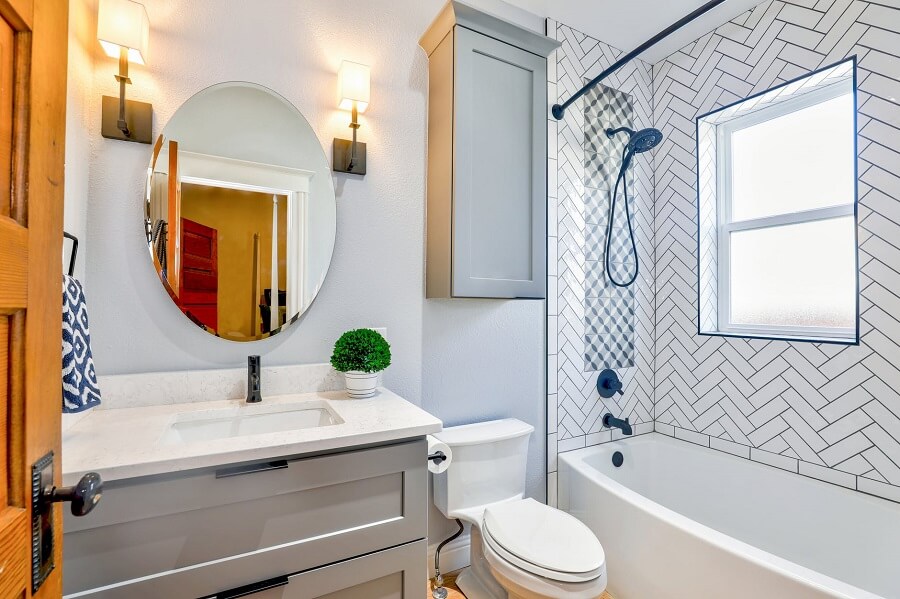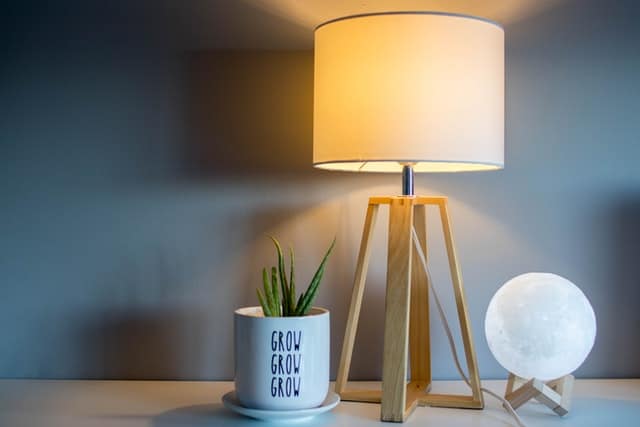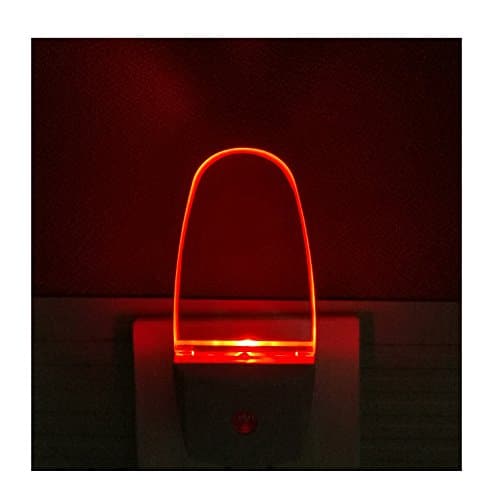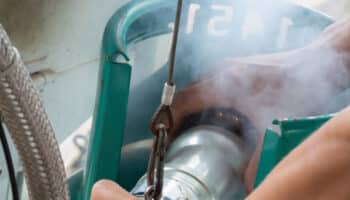Are you in the middle of replacing the lightbulbs in your bathroom? Then you’re probably wondering whether cool lights or warm lights will be best. This article will discuss which color temperatures are most effective in the bathroom.
Your bathroom light should be bright and white, mimicking natural light. For the most flattering bathroom light, your bulbs should do the following:
- Emit between 2,700 and 3,000 Kelvins (K)
- Have a Color Rendering Index (CRI) of over 80
Are you ready to dive into the details and find out the best color temperature for your bathroom? Then check out the more extensive bathroom lighting guide below.
Best Color Temperature for Bathroom Lighting

Have you ever got yourself ready in a poorly lit bathroom?
You sort your hair and your clothes. Everything looks fine when you look in the mirror. But then you get into the car and catch sight of yourself in the daylight of your rearview mirror. It’s only then that you realize that you are nowhere near presentable!
There’s breakfast between your teeth, a stain on your shirt, and toothpaste on your chin. How did you not notice all that in the bathroom mirror?
Now before you start panicking and making an emergency appointment with the eye doctor, there’s something you should consider. The lighting in your bathroom.
Here’s what happens if you don’t have the right temperature lighting in your bathroom:
- It can be difficult for you to differentiate certain colors.
- It can be tricky for you to pick up on the fine details.
Daylight is always the best light for seeing minute details, which explains why the best lighting for your bathroom is one that mimics daylight.
When choosing your next set of bathroom bulbs, how can you know which will be the best? Take a look at the following Kelvin and CRI guide to help you decide.
Kelvins and the Best Bathroom Temperature Lighting
Kelvin is the unit of measure for color temperature. The higher the Kelvin, the bluer the light.
The following is a list of some of our most familiar surroundings. Their color temperatures are measured in Kelvins (K):
- Daylight – 5,000 to 6,000 K. This light is ideal for reading and working. Daylight temperature maximizes contrasts between colors and makes it easier to spot minute details. (That is why it is easier to thread a needle in the light of a window than in a dark corner in the attic.)
- Bright White – 4,000 to 5,000 K. This light is just a fraction yellower than daylight. Bright white is the perfect shade for working environments, making it a great match for your home office and kitchen.
- Warm White – 3,000 to 4,000 K. This is a rather yellow light. Warm white is best suited for hallways and large rooms in the house.
- Soft White – 2,000 to 3,000 K. This light is ideal for the bathroom as it is the most flattering.
Now you may be wondering, isn’t Soft White too dark for a bathroom light? Well, that all depends on the CRI (Color Rendering Index) in your bulb. Take a look at the next section which will talk about CRI in more detail.
CRI and the Best Bathroom Temperature Lighting
CRI (Color Rendering Index) is a color rendering scale from 0 to 100. The higher the CRI the more accurate colors look under certain lighting. Light bulbs closer to 100 will bring out richer colors and heavier contrasts. They give the best reflection of a natural environment.
Light bulbs with a CRI of 80 or more are the best for bathrooms. These bulbs help to bring out the most natural color contrasts. When you look in the bathroom mirror they will give you a more realistic view of yourself in natural daylight.
You should combine the correct color temperature in Kelvin with the right CRI. This combination will give you the best light for your bathroom. So your bulb should be between 2,700K and 3,000K and measure over 80 CRI.
Bathroom Lighting and Safety
Aging eyes tend to have yellowing lenses. These make it more difficult for the elderly to see small details in poor lighting. As you age, you should consider using brighter lights in rooms that are hazardous. This is especially true of bathrooms where it is all too easy to slip and fall over.

You should choose a bulb that illuminates well and shows contrasts in the bathroom. This will help you avoid accidents, especially at night. Here are some of the best bulb options that use more cool light and are helpful to aging eyes:
- Halogen bulbs
- Cool fluorescent bulbs
You should consider changing your lightbulbs to a cooler, brighter color. This will help the elderly to feel more confident when moving around the house. It will better illuminate hazards and should reduce the risk of accidents.
What Color LED Is Best for Sleep?

If you’re anything like me, then it doesn’t take much to disturb your sleep at night.
It could be anything. Next door’s dog barking, the sound of the boiler running. You name it, it’ll have you up for hours.
And heaven forbid should you need the bathroom in the middle of the night. The dazzle from the fluorescent bathroom lighting in your eyes at 3 a.m. will instantly have your mind whizzing into overdrive.
So what can you do to prevent losing sleep at night? Well, there’s not much you can do about next door’s pesky dog or the irritating midnight boiler show. But, there is something you can do with your bathroom lighting so that it’s not such a shock to your system.
The following section explains how red light could be the solution to your lighting needs
Red Light
Red light has a low color temperature. It is ideal for evening lighting and lights that are left on or used briefly throughout the night. Red lights do not alter your internal clock like blue lights that reflect daylight help to keep us alert. Red lights have lower Kelvins and CRI levels. They illuminate but without disrupting your sleep pattern.

It could be helpful to switch to red lights in your bathroom at night. Red lights may help your body to ease back into sleep more easily if you have to wake up at night to use the bathroom.
Okay, so what’s the solution? Using bright fluorescent bulbs throughout the day and then frantically changing them to red light bulbs at night? There has got to be a better way. And there is! Check it out below.
Smart Bulbs
Smart bulbs are lightbulbs that change their lighting according to the time of day. That means that in the daytime they will emit blue light. Blue light reflects daylight and that helps to keep us alert. In the evenings and throughout the night they emit red light. Red light is known to be conducive to good sleep patterns.
Smart bulbs are not set in some rigid, unbreakable sequence of bright in the day and dull at night. If you are reading in the day and fancy a cozier light, you can change it! It is easy to change the settings on a smart bulb so that they reflect your mood and not just the time of day.
Smart bulbs are ideal for those who are easily disrupted while sleeping. You should consider replacing your bathroom bulbs with smart bulbs. Automated lighting could make it easier for you to go back to sleep after going to the bathroom at night.
You should also change the lightbulbs in your kitchen and hallways. This way, should you need to get up at night for a drink of water, you will not be disturbed by piercing LED lights that will keep you awake for hours.
Conclusion
Picking a color temperature bulb for your bathroom can be tricky. The market seems to be saturated with options and they all look pretty much the same. It can be confusing to work out which level of Kelvin or CRI your bathroom bulbs should have. I hope this article has helped you to see the ideal color temperature for bathroom lighting.
If this article’s helped you, please consider supporting us by checking out some more of our free guides or signing up to our e-mail list.
Thanks for reading, and have a great day!
Craig







